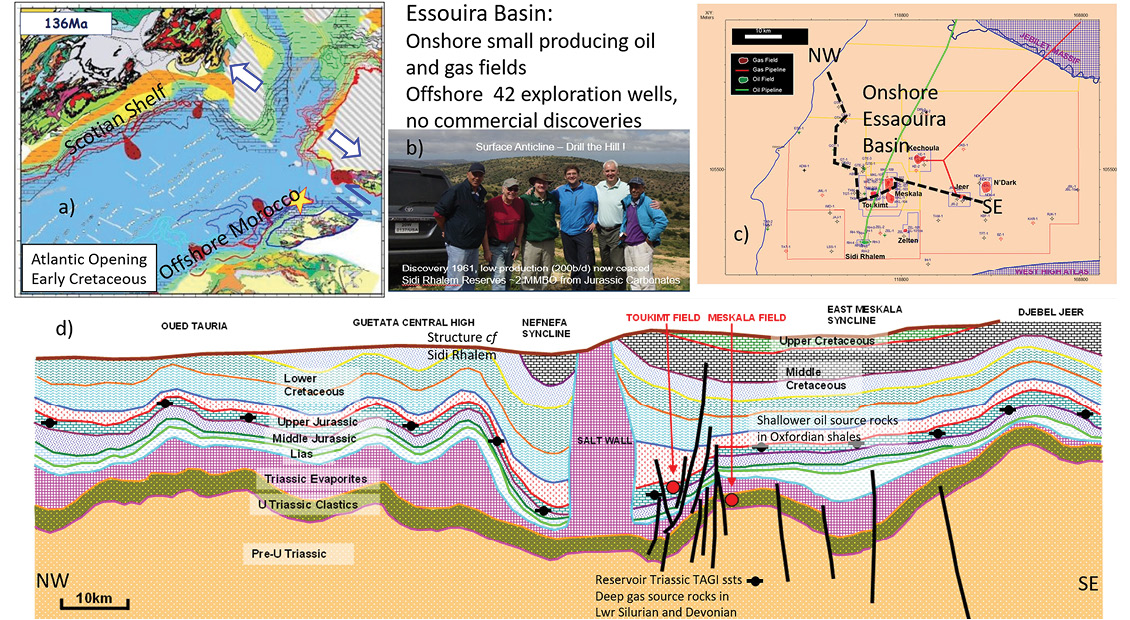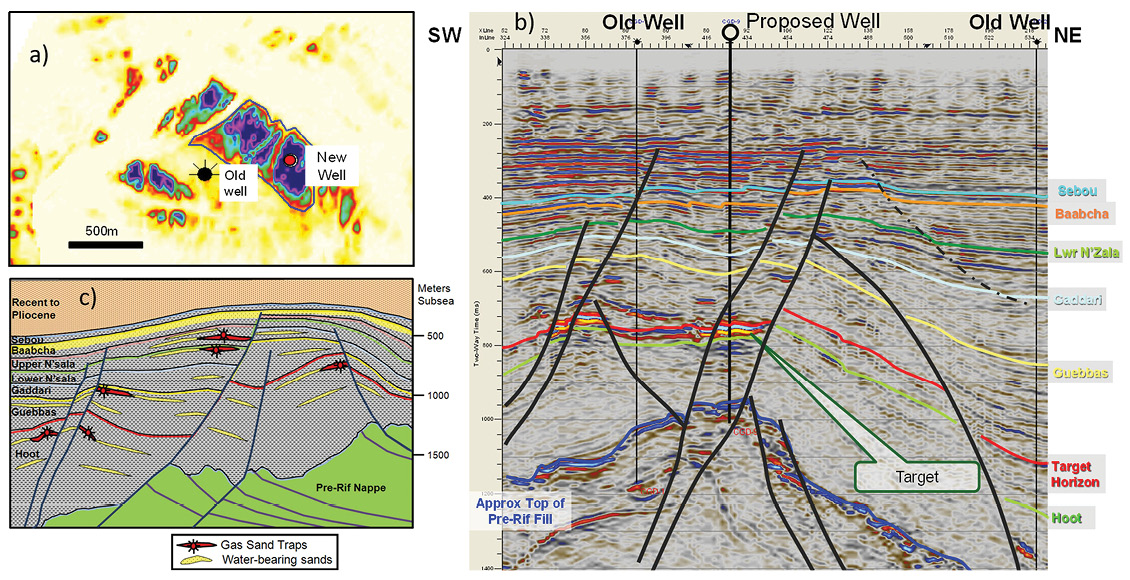There are three productive basins in Morocco: Essaouira, Tendrara and Rharb, with the majority of fields lying onshore (Figure 1). The hydrocarbon volumes found and produced in these basins are very low in comparison to their aerial extents. This is possibly the result of underexplored stratigraphy and trap types and/or possibly due to underperformance of the petroleum systems themselves. The principal petroleum systems of the three basins are detailed and illustrated below.
Essaouira Basin
Lying on the Atlantic coast, this basin has a similar Pre-Tertiary geological history to the Scotian Shelf on the conjugate margin of Canada (Figure 2a). The stratigraphy of the Essaouira Basin can be divided up into the pre-rift Palaeozoic section culminating in the Hercynian compressive events, a syn-rift Triassic to mid-Jurassic section deposited during the Proto-Atlantic opening, and the post-rift Late Jurassic to Late Tertiary section culminating in the Atlassic compressive events. Potential source rocks are located in the Siluro-Devonian and Lower Oxfordian shales; however, the true distribution of the source rocks remains uncertain. The principal reservoir rocks are found in fractured Argovian (Middle Oxfordian) carbonates and thinly bedded Upper Triassic fluvial sandstones. Potential reservoirs are found in fractured Devonian carbonates, Ordovician sandstones and Liassic carbonates. Seals are present throughout the succession, but of note above the main reservoirs are the Late Jurassic evaporite/carbonate section, the Upper Triassic Evaporite, basal Triassic shales and Siluro-Devonian shales.
There has been a resurgence of activity in the offshore area over the past decade where sizeable structures have been drilled. However, the onshore petroleum systems, with Jurassic source rocks and carbonate reservoirs and Cretaceous carbonates and clastics, has remained enigmatic and to date, no commercial successes have been recorded. Onshore, the working Jurassic–Cretaceous petroleum system is illustrated by the small Jurassic Sidi Rhalem field (discovered in 1961, Figures 2b–d). The distribution of mature Oxfordian source rocks is limited (as is the prospectivity of shallow targets) by the generally shallow depth of burial. However, there is a more deeply buried Palaeozoic–Triassic system and Triassic fluvial sands of the TAGI that are productive in the Meskala gas field, discovered in 1977 and operated by the Moroccan National Company, ONHYM. A key element of the Essaouira Basin fields is the Triassic salt providing a seal for Meskala and structural deformation of the overlying strata by halokinesis. However, Jurassic–Cretaceous traps appear to be small to moderate in size and improved seismic coverage is needed to better define drilling targets. The deeper Palaeozoic has yet to become a more popular target for exploration.
Tendrara Basin
Situated in eastern Morocco near the Algerian border and sharing similar geology, this basin has the potential to provide substantial gas reserves (Figure 3a). However, the location is fairly remote and the area is some 120 km south of the Maghreb–Europe gas pipeline. The main gas-bearing horst structure was discovered by Maghreb Petroleum in 2006. Recent drilling by Sound Energy (current operator) has had mixed results primarily because it is difficult to predict reservoir quality within the the TAGI sands, leading to a change of development to using micro-LNG plants for gas export from the current Tendrara discovery, rather than building a connecting pipeline to the north. The source rocks are the deeply buried Lower Silurian shales and like Meskala the caprock is provided by the overlying Triassic salt (Figures 3b–c). There is upside potential in the Palaeozoic, similar to that of the Essaouira Basin with reservoirs in both the Devonian and Ordovician. The rift-generated horst block trapping style is present over a wide area and further drilling is needed to delineate the ultimate extent of the Tendrara plays.
Rharb Basin
Located to north of the Moroccan capital of Rabat and south of Tangier and the Rif Mountains, the Rharb Basin contains a thick succession of Late Tertiary sediments. Exploration based on field geology and on the presence of surface oil seeps started in 1890 (Figure 4a–b). The Ain Hamra field was discovered in 1923. Field mapping of surface structures and later magneto-telluric surveys continued through to the 1950s with the discovery of some small shallow oil fields (Tselfat, Haricha and Bou Draa) and a series of small gas fields on the Sidi Fili trend associated with thrust folds in the Rif Mountain front (Figure 4c). The Mesozoic rocks involved in this thrusting as the African plate collided with Europe in the mid-Tertiary, are collectively known as the ‘Nappe’. The later Miocene to recent sediments of the foreland basin are locally termed the ‘Supra-Nappe’.
Petrofina started using multitrace seismic in the 1960s leading to several small gas discoveries. In the 1970s with the advent of ‘bright spot’ technology, additional gas discoveries were made, though several dry holes were also drilled. 2D seismic was the ‘norm’ in the Rharb until the winter of 2007–2008, when Circle Oil acquired a 3D seismic survey over the Sebou concession, which had been granted in 2006. The initial drilling programme commenced in September 2008 following interpretation of the 3D seismic and the first well was successfully tested as a gas discovery which was tied back into the existing small capacity pipeline to the local industry in the coastal town of Kenitra. First gas was produced in November 2008 and during the author’s time at Circle Oil, further drilling campaigns achieved an 85% success ratio to mid-2015. The succeeding operator has been Sea Dragon Energy who have continued with the play concept and have had further success.
A sequence stratigraphic subdivision of the mudrock-dominated Mio-Pliocene ‘Productive Series’ was used by Circle Oil to distinguish and map eight units for the central part of the Rharb Basin (Figure 4a–c). The gas-bearing sands are of good reservoir quality, but usually thinly bedded (1–15m). The sands appear to have been sourced from erosion of the uplifted Rif Mountains and transported into the Miocene foreland basin to the southwest into the opening eastern margins of the Atlantic Ocean. There are no Late Miocene evaporites in the Rharb Basin, as the Rif Mountains formed a barrier to marine incursions from the Mediterranean to the north. A recent exploration venture on the eastern margin of Morocco’s Mediterranean coast in the Guercif Basin is underway by Predator Oil and Gas holdings. The block lies 180 km north of the Triassic Tendrara discovery, but there is a different objective. Predator are targeting the same Miocene sands interval as the Rharb gas fields for shallow gas.
Modern 3D Seismic Application
Where gas bearing, the seismic response of the sands shows up as bright negative amplitudes, due to the lower density and slower seismic velocity compared to the water-bearing sands and the encasing mudrocks (Figure 5). Modern 3D seismic makes the location and geometry of these anomalies stand out as clear drillable targets. The gas is contained in combination structural-stratigraphic pinchout traps, with top, bottom and lateral seals provided by coeval marls and shales. The reserves of the small onshore gas fields discovered to date, range from 1 to 20 Bcf. Circle Oil built a new gas pipeline to Kenitra on the coast for export and sale to local industries in 2011. Much larger structures are present in the offshore extension of the Rharb Basin, where ENI discovered the Anchois gas field in 2009. At that time the discovery was considered too small for development; however, Chariot Transitional Energy have taken over the blocks including Anchois, and the company has reprocessed and interpreted the 3D seismic and is now proceeding with development plans.
The example shown in Figure 5a–b illustrates the accurate placement of a gas discovery only 800m away from an abandoned well, based on amplitude extraction and geological understanding of the trapping mechanism. The faulting as shown is currently normal over the crest of a thrust anticline in the Nappe. The effective keystone stretching of the overlying younger rocks has created the structural trap and provided a migration pathway for hydrocarbons generated from the Jurassic/Cretaceous source rocks. Sourcing from the coeval, organically lean Miocene mudrocks is unlikely to provide local biogenic gas and the more likely source is considered to be the biogenic degradation by bacteria of an original thermogenic liquid phase hydrocarbon. This has been also reported by Sea Dragon Energy for their recent discovery in the Lalla Mimouna Block located just to the north of the previously successful Sebou Block in the Rharb Basin. The apparent lack of reservoir quality rocks in the few wells drilled to date into the ‘Nappe’ succession may locally downgrade the prospectivity of those strata.
Unfulfilled Potential
Morocco’s productive petroleum basins appear to suffer from a mixture of under-exploration and underperformance. This may be due to the failure of early wells and then poor follow-through exploration ideas. Deeper drilling and alternative target horizons and traps have often led to success in other petroleum basins such as the Alberta Basin in Western Canada, as well as the North Sea. New exploration concepts and technology improvements are essential to the rejuvenation and success of exploration ventures. Just as in some of my old school end-of-year reports, perhaps explorers in Morocco – ‘could try harder and do better’.










